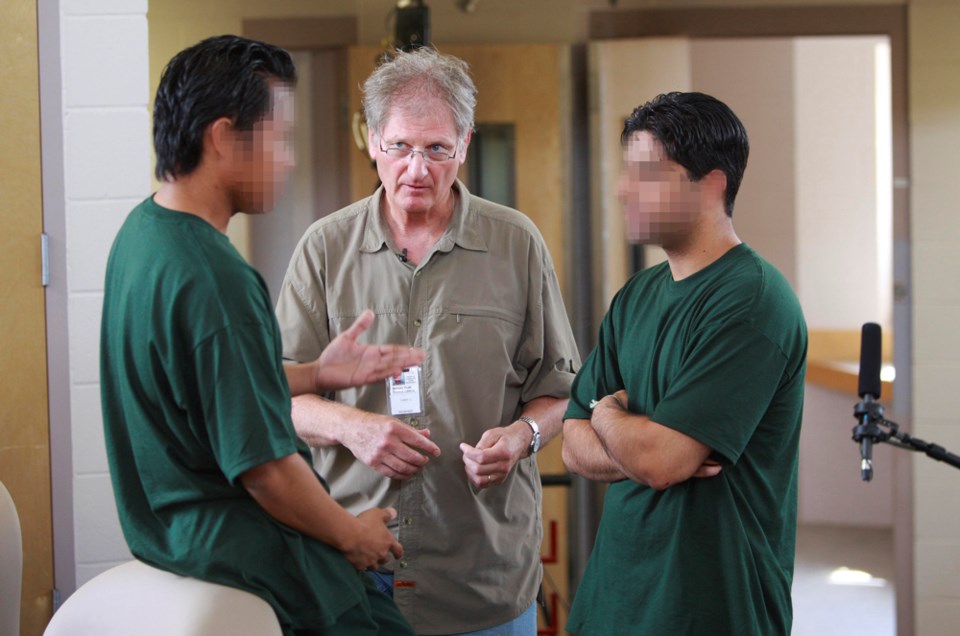Filmmaker Larry Lynn describes himself as both priest and sinner.
“I’m trying my best ... to try to bring a little light into the darkness of the world,” he says.
As part of his calling to spread light in the world, Father Lynn started volunteering in Burnaby’s youth prison in 2001, teaching kids film. His work there eventually lead to the creation of Kids in Jail, a 45-minute documentary recently released by the National Film Board. Kids in Jail tells the love story of two teens, Diamond and Phoenix, forbidden to see each other while in prison. Lynn had extraordinary access while filming, thanks to his years of volunteer work. The film is available online. It’s one of 60 the National Film Board is showing online for free.
Lynn has spent four decades working in film, and he’s won numerous awards for his work. The City of Burnaby gave him a local hero award in 2005 for his work with incarcerated youth. He used to live in Burnaby with his late wife, well-known actress Babs Chula, who passed away from cancer in 2010. Just weeks before she died, she predicted that Lynn would become a monk. He recently became a Roman Catholic Priest and now lives in West Vancouver.
Q&A:
What were you doing in the youth prison?
When I first started, I was just playing basketball. … I was eventually encouraged to start a program, a program where I would be teaching them about communication skills, film and storytelling, making films, making little animation films, making short little films.
How did you come up with the idea to do a documentary?
I thought if they are making a film, I can be making a film about what we are doing there and get to know their stories.
The film is about a relationship between two youth in the prison, who committed “horrific crimes.” Can you tell us what they did?
They tell you in the film. So I prefer they tell you.
Tell us a bit about the film. There are these two youth, and they’re in a relationship, but they are not allowed to see each other?
It came down as an edict from the government - from very high levels of government - that girls and boys could no longer be in the same units. And it was for good reasons. It was for reasons that the boys were intimidating, and there was a little bit of sexual stuff going on, and boys were recruiting girls for the outside. It was a very unhealthy situation. … It was the Elizabeth Fry Society that really lobbied for that (separation) to happen, but interestingly, these two young people thought it was all about them. They thought it was happening because of them, so they took it very personally. So they wrote a film … based on that story. That was called A Gesture.
What was the most surprising thing you learned while working with these kids in jail?
I guess the most surprising thing is how human beings can do (terrible) things. They look like normal, natural human beings, but they are capable of great harm to other human beings. I think that’s in all of us.
How do reconcile that with this relationship you built up with the youth, which involves some trust?
That’s the whole thing. It’s funny. I would never for a moment judge these kids. In fact, I had to get them to look at themselves in a way that they could see themselves in a positive light even though they’ve done terrible things.
What do you hope the audience takes away from your film?
I hope the audience takes away from the film that we need to love one another more, all of us need to love one another more, not just the people we know and love and like, but to love the people that we actually (know) who they are, and we don’t even like them, that we are called to love them anyway.
You’ve worked in film since 1976, and you’ve won countless awards. Why did you decide to become a Roman Catholic priest?
I didn’t decide. And this is the truth. I’m not being coy. The circumstances were such that I was entering into a new level of my faith. I walked with my wife through her cancer, and walked with her all the way to the end. After that, the Lord called me to the priesthood so I could be of service to the church and to people.
Are you still making films?
I am. I am in the middle of making one now. … It’s a film about the Catholic church and the aboriginal people moving forward together.
Very interesting. How does your faith inform your film work?
I cannot separate out who I am, which is a disciple of Jesus Christ, from my work or whatever I do. … My faith defines who I am pretty much.



